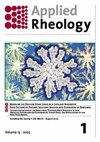利用大振幅振荡剪切和拉伸流变学预测化妆品的感官质地
IF 1.8
4区 工程技术
Q1 MECHANICS
引用次数: 0
摘要
我们基于迄今为止最大的流变学和面板测试感官质地数据库,利用机器学习技术提出了一种针对各种感官质地的预测模型。除了化妆品领域通常测量的传统流变参数外,我们还采用了从大振幅振荡剪切(LAOS)物理过程序列(SPP)和延伸流变分析中获得的流变参数作为预测模型的特征变量。选择这些特征变量是为了模拟化妆品使用过程中的真实流动条件,如摩擦和敲击,因为它们有望包含更多与感官质地相关的信息。结果表明,我们基于随机森林回归算法的预测模型可以有效预测五种感官质地:延展性、厚度、柔软度、粘附性和粘性。我们通过排列分析和特征重要性分析研究了决定每种感官质地的关键流变特征。重要度分析强调了来自 LAOS-SPP、延伸分析的流变参数与感官质地之间的紧密相关性。利用这种相关性,我们可以在流变学的背景下解释对每种感官质地的感知。本文章由计算机程序翻译,如有差异,请以英文原文为准。
Prediction of sensory textures of cosmetics using large amplitude oscillatory shear and extensional rheology
We propose a predictive model for various sensory textures utilizing machine learning techniques based on the largest rheology and panel-tested sensory texture database ever assembled. In addition to the conventional rheological parameters typically measured in the cosmetics field, rheological parameters obtained from the large amplitude oscillatory shear (LAOS) sequence of physical processes (SPPs) and extensional rheology analyses are employed as feature variables for the predictive model. These feature variables are chosen to mimic real flow conditions during the usage of cosmetics, such as rubbing and tapping, as they are expected to contain more information related to sensory textures. It has been demonstrated that our prediction model, based on the random forest regression algorithm, can effectively predict five sensory textures: spreadability, thickness, softness, adhesiveness, and stickiness. We investigated the rheological characteristics crucial for determining each sensory texture through permutation and feature importance analyses. The important analysis highlighted the close correlation between rheological parameters from LAOS–SPP, extensional analyses, and sensory textures. By using this correlation, we interpret the perception of each sensory texture in the context of rheology.
求助全文
通过发布文献求助,成功后即可免费获取论文全文。
去求助
来源期刊

Applied Rheology
物理-力学
CiteScore
3.00
自引率
5.60%
发文量
7
审稿时长
>12 weeks
期刊介绍:
Applied Rheology is a peer-reviewed, open access, electronic journal devoted to the publication in the field of applied rheology. The journal provides the readers with free, instant, and permanent access to all content worldwide; and the authors with extensive promotion of published articles, long-time preservation, language-correction services, no space constraints and immediate publication.
 求助内容:
求助内容: 应助结果提醒方式:
应助结果提醒方式:


